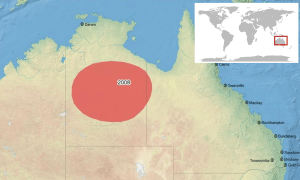Olive water-holding frog facts for kids
The olive water-holding frog, also known as the spotted collared frog or Daly Waters frog (Ranoidea maculosa), is a type of frog found in Australia. Scientists have mainly seen this frog in the Northern Territory, with a few sightings just over the border in Queensland. It gets one of its names from a specific area called Daly Waters.
Quick facts for kids Olive water-holding frog |
|
|---|---|
| Conservation status | |
| Scientific classification | |
| Genus: |
Ranoidea
|
| Species: |
maculosa
|
 |
|
| Most of this frog's range is in the Northern Territory, with a small part in Queensland. | |
| Synonyms | |
|
|
Contents
About the Olive Water-Holding Frog
This frog is quite small, growing to about 5.0 centimeters (2 inches) long. Its skin on the back is usually a pale color. However, it has very dark, almost black, marks or spots all over its body. These marks give it a unique look.
Where These Frogs Live
The olive water-holding frog lives in parts of northern Australia. Its main home is in the Northern Territory. A smaller number of these frogs are also found in nearby Queensland. They prefer areas where they can find water, especially during the wet season.
How They Survive Dry Times
The name "water-holding frog" gives us a big clue about how these frogs survive. In Australia, many areas have long dry periods. During these times, water can be very scarce. These special frogs have an amazing way to cope.
Storing Water Underground
When the dry season arrives, the olive water-holding frog digs a burrow deep underground. It creates a cozy, moist chamber for itself. To save water, its skin becomes less permeable, meaning less water can escape. It can also store water in its bladder. This allows the frog to stay underground for many months. It waits there until the rains return.
Waiting for the Rain
The frog stays in its underground burrow, sometimes for a year or more. It enters a special sleepy state called aestivation. This is like hibernation, but for hot, dry conditions. When the heavy rains finally come, the ground softens. The frog then digs its way out, ready to find food and reproduce.
Life Cycle and Reproduction
Like most frogs, the olive water-holding frog starts its life as a tadpole. When the rains create temporary pools of water, the adult frogs come out to breed. They lay their eggs in these pools.
From Tadpole to Frog
The eggs hatch into tadpoles, which are tiny water creatures. Tadpoles live in the water and eat algae. They grow quickly, changing into small frogs. This change is called metamorphosis. Once they become frogs, they can live on land, but they still need moisture.
See also
 In Spanish: Ranoidea cultripes para niños
In Spanish: Ranoidea cultripes para niños


